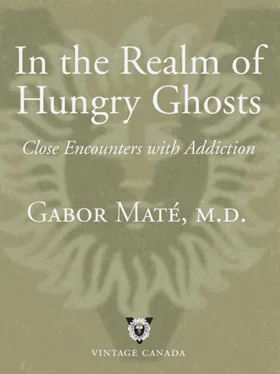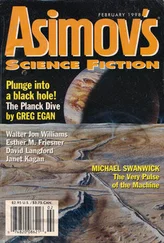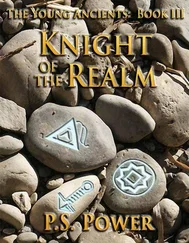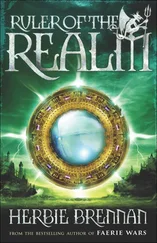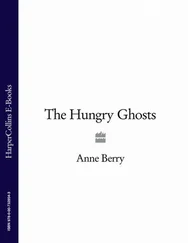The scientific literature is nearly unanimous in viewing drug addiction as a chronic brain condition, and this alone ought to discourage anyone from blaming or punishing the sufferer. No one, after all, blames a person suffering from rheumatoid arthritis for having a relapse, since relapse is one of the characteristics of chronic illness. The very concept of choice appears less clear-cut if we understand that the addict’s ability to choose, if not absent, is certainly impaired.
“The evidence for addiction as a different state of the brain has important treatment implications,” writes Dr. Charles O’Brien.
“Unfortunately,” he adds, “most health care systems continue to treat addiction as an acute disorder, if at all.”
CHAPTER 14

Through a Needle, a Warm Soft Hug
All the substances that are the main drugs of abuse today originate in natural plant products and have been known to human beings for thousands of years.
Opium, the basis of heroin, is an extract of the Asian poppy Papaver somniferum. Four thousand years ago, the Sumerians and Egyptians were already familiar with its usefulness in treating pain and diarrhea and also with its powers to affect a person’s psychological state. Cocaine is an extract of the leaves of Erythroxyolon coca, a small tree that thrives on the eastern slopes of the Andes in western South America. Amazon Indians chewed coca long before the Conquest, as an antidote to fatigue and to reduce the need to eat on long, arduous mountain journeys. Coca was also venerated in spiritual practices: Native people called it the Divine Plant of the Incas. In what was probably the first ideological “War on Drugs” in the New World, the Spanish invaders denounced coca’s effects as a “delusion from the devil.”
The hemp plant, from which marijuana is derived, first grew on the Indian subcontinent and was christened Cannabis sativa by the Swedish scientist Carl Linnaeus in 1753. It was also known to ancient Persians, Arabs and Chinese, and its earliest recorded pharmaceutical use appears in a Chinese compendium of medicine written nearly three thousand years ago. Stimulants derived from plants were also used by the ancient Chinese, for example in the treatment of nasal and bronchial congestion.
Alcohol, produced by fermentation that depends on microscopic fungi, is such an indelible part of human history and joy making that in many traditions it is honoured as a gift from the gods. Contrary to its present reputation, it has also been viewed as a giver of wisdom. The Greek historian Herodotus tells of a tribe in the Near East whose council of elders would never sustain a decision they made when sober unless they also confirmed it under the influence of strong wine. Or, if they came up with something while intoxicated, they would also have to agree with themselves after sobering up.
None of these substances could affect us unless they worked on natural processes in the human brain and made use of the brain’s innate chemical apparatus. Drugs influence and alter how we act and feel because they resemble the brain’s own natural chemicals. This likeness allows them to occupy receptor sites on our cells and interact with the brain’s intrinsic messenger systems.
But why is the human brain so receptive to drugs of abuse? Nature couldn’t have taken millions of years to develop the incredibly intricate system of brain circuits, neurotransmitters and receptors that become involved in addiction just so people could get “high” to escape their troubles or have a wild time on a Saturday night. These circuits and systems, writes a leading neuroscientist and addiction researcher, Professor Jaak Panksepp, *15must “serve some critical purpose other than promoting the vigorous intake of highly purified chemical compounds recently developed by humans.” 1Addiction may not be a natural state, but the brain regions it subverts are part of our central machinery of survival.
I catch myself edging into a trap here. By writing that addiction “subverts” the brain, I realize I’m feeding the impression that addiction has a life of its own, like a virus invading the body, a predator ready to pounce or a foreign agent infiltrating an unsuspecting host country. In reality, the constellation of behaviours we call addiction is provoked by a complex set of neurological and emotional mechanisms that develop inside a person. These mechanisms have no separate existence and no conscious will of their own, even if the addict may often experience himself as governed by a powerful controlling force or as suffering from a disease he has no strength to resist.
So it would be more accurate to say: addiction may not be a natural state, but the brain regions in which its powers arise are central to our survival. The force of the addiction process stems from that very fact. Here’s an analogy: let’s say the section of someone’s brain that controls body movements—the motor cortex—was damaged or did not develop properly. That person would inevitably have some kind of physical impairment. If the affected nerves managed nothing more than the motions of the little toe, any loss would hardly be noticeable. If, however, the damaged or undeveloped nerves governed the activity of a leg, the person would have a significant disability. In other words, the impairment would be proportional to the size and importance of the malfunctioning brain centre. So it is with addiction.
There is no addiction centre in the brain, no circuits designated strictly for addictive purposes. The brain systems involved in addiction are among the key organizers and motivators of human emotional life and behaviour; hence, addiction’s powerful hold on human beings. Three major networks are involved. We’ll look at the opioid apparatus in the rest of this chapter and, in Chapters 15 and 16, respectively, the dopamine system (which performs incentive-motivation functions) and the self-regulation system in the cortex, or grey matter. The defining molecules of the opioid apparatus are the brain’s “natural narcotics”—the endorphins.

It was in the 1970s that an innate opioid system was first identified in the mammalian brain. The protein molecules that serve as the chemical messengers in this system were named endorphins by the U.S. researcher Eric Simon because they are endogenous—they originate within the organism—and because they bear resemblance to morphine. Morphine and its opiate cousins fit into the brain’s endorphin receptors and thus, to quote a textbook on addiction research, the main endorphin receptor “represents the molecular gate for opioid addiction.” 2Humans are not the only creatures who have an innate opiate system. We share this pleasure with our near and distant relatives on the evolutionary ladder. Even one-celled organisms produce endorphins.
Not surprisingly, endorphins do for us exactly what plant-derived opioids can do: they’re powerful soothers of pain, both physical and emotional. They grant, in the words of that opiate disciple Thomas De Quincey, “serenity, equipoise…the removal of any deep-seated irritation.” For the distracted and soul-suffering person, a hit of endorphins, just like an infusion of opium products, “composes what has been agitated, concentrates what has been distracted.” 3
Beyond their soothing properties, endorphins serve other functions essential to life. They’re important regulators of the autonomic nervous system—the part that’s not under our conscious control. They affect many organs in the body, from the brain and the heart to the intestines. They influence mood changes, physical activity and sleep and regulate blood pressure, heart rate, breathing, bowel movements and body temperature. They even help modulate our immune system.
Читать дальше
